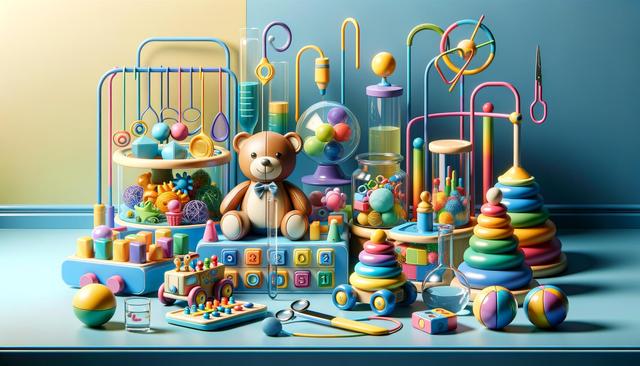Supporting Early Development: A Guide to Toddler Learning Toys
Toddler learning toys play an important role in fostering crucial developmental skills during the early years.

Understanding the Role of Learning Toys in Toddler Development
During the toddler years, children experience rapid cognitive, physical, and emotional growth. Learning toys can play a supportive role by providing stimulating experiences that encourage exploration and development. These toys are designed to promote skills such as problem-solving, hand-eye coordination, language acquisition, and social interaction. When chosen thoughtfully, they can complement everyday learning and help toddlers build confidence and independence through play.
At this stage, children learn best through hands-on experiences. Toys that encourage manipulation, sorting, stacking, and cause-and-effect relationships tend to be especially engaging. These activities help toddlers make sense of the world around them while reinforcing patterns and routines. Simple puzzles, shape sorters, and stacking rings are common examples of items that inspire this type of interactive learning.
Parents and caregivers should also consider how a toy aligns with a child’s current developmental stage. What works for an 18-month-old may not be challenging enough for a 2.5-year-old. Therefore, choosing toys that grow with the child or offer multiple levels of engagement can provide continued value over time.
Key Features to Look for in Toddler Learning Toys
When selecting learning toys for toddlers, it’s important to consider safety, durability, and developmental appropriateness. Toddlers explore with all their senses, so toys should be made of non-toxic materials and be free from small parts that could pose a choking hazard. Additionally, toys should be sturdy enough to withstand rough handling and repeated use.
Look for toys that encourage:
- Fine motor skill development (e.g., lacing beads, nesting cups)
- Gross motor activity (e.g., ride-on toys, push-and-pull toys)
- Language and communication (e.g., picture books, talking toys)
- Emotional and social learning (e.g., role play sets, dolls)
Interactive features such as lights, sounds, and textures can further enhance engagement, though they should not overwhelm the child. Simpler designs that promote creativity and imagination often yield longer-lasting interest. Open-ended toys, such as building blocks or pretend play sets, allow for a wide range of activities and skill-building opportunities.
Encouraging Cognitive Skills Through Play
Learning toys can effectively support cognitive development by helping toddlers recognize patterns, solve problems, and make decisions. Memory games, matching cards, and shape sorters stimulate mental activity by encouraging toddlers to observe, compare, and recall information. These activities help build the foundation for more complex thinking in later years.
One effective approach is to introduce toys that focus on:
- Sorting and categorizing objects by color, size, or shape
- Sequence and order through stacking or nesting activities
- Problem-solving through trial and error, like fitting puzzle pieces together
- Early numeracy and literacy through counting toys or alphabet blocks
While using these toys, caregivers can further reinforce learning by asking questions, narrating actions, and encouraging toddlers to express their thoughts. This back-and-forth interaction not only supports comprehension but also strengthens the caregiver-child bond.
Promoting Social and Emotional Learning with Toys
As toddlers begin to interact more with others, social and emotional skills become increasingly important. Learning toys that simulate real-life experiences or require cooperative play can help children practice empathy, sharing, and turn-taking. Dolls, play kitchens, and doctor kits are examples of toys that encourage role-playing and help toddlers understand different perspectives.
These toys support emotional development by allowing children to:
- Express feelings through imaginative scenarios
- Develop empathy by caring for dolls or stuffed animals
- Learn social rules like taking turns and following directions
- Build confidence by completing tasks and making decisions
Group play with siblings or peers also teaches valuable lessons in negotiation, patience, and listening. Even simple board games for toddlers can introduce the concepts of winning and losing in a gentle, age-appropriate way.
Balancing Screen-Free and Electronic Learning Toys
In today’s digital age, many toddler learning toys incorporate electronic elements. While these can offer interactive learning experiences, it’s essential to strike a balance with traditional, screen-free toys. Excessive reliance on electronic toys may limit opportunities for open-ended play and reduce the role of imagination and physical interaction.
Screen-free toys such as:
- Wooden blocks and building sets
- Art supplies like crayons and finger paints
- Musical instruments made for toddlers
- Outdoor play equipment
can support creativity, sensory exploration, and active movement. When electronic toys are used, they should feature age-appropriate content and encourage active participation rather than passive viewing. For example, a toy that prompts the child to repeat words or follow directions can be more effective than one that simply plays music or sounds without interaction.
Ultimately, a mixed approach that includes both types of toys can offer variety and maintain a toddler’s interest while covering multiple areas of development.
Conclusion: Choosing Toys That Grow with Your Toddler
Learning toys offer meaningful ways to support a toddler’s growth across cognitive, physical, and emotional domains. By selecting toys that match a child’s developmental stage and encourage active engagement, caregivers can foster a love for learning early on. The key is to provide a balanced and stimulating environment where children can explore at their own pace.
Whether through imaginative play, problem-solving activities, or social interaction, toddler learning toys serve as valuable tools in early education. Investing in versatile, safe, and thoughtfully designed toys can make a lasting impact on a child’s development and help lay the foundation for lifelong learning.